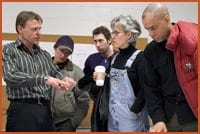Ottawa’s queer community finally had its chance to be heard on the proposed renovations for the emerging gaybourhood.
After leaving gays and lesbians out of the initial process of planning renovations to Bank St, the city held a public meeting on Feb 15 at the Jack Purcell Community Centre to gather input on streetscaping designs.
Currently, more than 30 queer-owned businesses call the area of Bank between Somerset and Gladstone home, but only a few representatives from the gay-identified business community attended this meeting. Nearly 100 people did show up, though, mostly average queer citizens concerned about how their village will look and feel in the upcoming years.
Diane Holmes, the city councillor for the area, Richard Holder, city project manager for the construction, and John Wright, city surface designer for the project, all attended to answer questions.
The audience made requests for changes such as rainbow flags, themed benches and specific street signage. Safety concerns prompted calls for more payphones, and laughs emerged when someone hollered, “Make them prettier payphones.”
But serious concerns such as getting rid of barriers of isolation that Ottawa’s queer community feels were also expressed at this meeting.
“As a lesbian, there’s no safe place for me to go, to feel proud. We need an area where we feel a sense of pride in who we are,” shouted Marie Robertson, receiving applause.
Having a recognized community is crucial to young queers, said one Ottawa student.
“For gay students, having a more visible gay community is more important than gay marriage,” said James Bromilow, a student from the University Of Ottawa. “I think [investing in a more visible] gay community can contribute to arts and culture. There are a lot of queer students. A vibrant, accessible gay community is what will draw them.”
After the meeting, Bromilow said that coming from Kapuskasing, the main reason why he chose to go to school in Ottawa was because of its gay community.
“Having a gay community is important to gay students. If you come from a small town and you’re gay, you’re going to be looking for somewhere that’s safe, that’s your own community, one that you can feel comfortable with.”
But some warned that people had to be realistic, and bear in mind the community’s ability to financially contribute towards the Bank St streetscape designs.
“Our community is quite over-extended giving money to charities,” said Nathan Hauch. “We’d need some assistance outside of that. We’d hate to come up with some grandiose plan and not have it come through because we can’t raise enough funds.”
Compromise is needed in order to see an effective streetscape design project go forward, said Gerry LePage, the executive director of the Bank Street Business Improvement Area.
“If we’d like to be like Vegas and have a light show, that’d be great. But who’s got $50 million for that? For every idea we have, there’s some level of government saying no,” LePage said, adding that he’s never seen so much concern for such a small strip of street.
But not everyone at the meeting was sure that turning that strip into a gay district would be a good thing for Ottawa’s queer community.
“We have so many different people in that area. There is a [queer] community emerging in Westboro. How do we bring one section together and sustain it? Is the section going to be named before it exists?” said Parkdale resident Marion Steele.
But those attending were relieved that the city was finally discussing the plans.
“First of all, the city’s actually been thinking of this ahead of time after leaving us out of their whole process. I think the discussion was productive and we were heard,” said Robertson after the meeting.
But others said still more needed to be done.
“There is still not an official recognition of the gay district,” Gareth Kirkby, Capital Xtra associate publisher and managing editor, told the meeting. “We want to make sure the community is involved on an ongoing basis. Outreach has to go beyond the BIA. There has to be bridge-building between the community and the upper powers.”
Cecil Turcotte, who lives in the market, said including the queer community is a positive step made by city officials, but that “it should’ve happened a lot earlier in the process.”
Turcotte was one of several who volunteered to be the community representative for the public advisory committee (PAC) for the construction phases on Bank St.
“I’d like to see the designs reflect public input and the community’s vision into the end product,” said Turcotte.
The 2006 budget for work on Bank St only allows construction on the stretch from Wellington to Laurier streets. Another public advisory committee for the proposed construction from Laurier to Gladstone will be formed soon, said Holder, and construction is scheduled for 2009.
“I’d like to work a little earlier than that,” said Holmes, adding that she’d like to see a public advisory committee be formed by July, 2007 for the Laurier to Gladstone construction. “There will come a time to lobby the city, and there will be a time to go to the BIA to express interest. And there will be a time when we’ll need a warm body for that.”

 Why you can trust Xtra
Why you can trust Xtra


